In the past year, we have witnessed groundbreaking advancements that have revolutionized the potential uses of AI for businesses.
Some musicians used AI voice cloning to create synthetic music that sounds like the music of famous artists such as Eminem.
Corporate giants like Coca-Cola began generating ads partly through AI, while Levi’s said it would use AI to create virtual models.
In late 2023, paid users of ChatGPT can benefit from voice and image capabilities. Adobe has also incorporated generative AI into its software offerings, including Illustrator and Photoshop.
As we move forward into 2024, the constantly evolving world of artificial intelligence (AI) offers exciting prospects for businesses. What can we expect this year?
Multitasking Robots: The Future of Automation
Following the trend in generative AI, roboticists are now developing versatile, general-purpose robots, aiding in a range of industries from manufacturing to customer service. This shift towards multifunctional automation solutions makes businesses more adaptable and efficient.
The evolution of AI chatbots is another revolution in customer interaction. These chatbots, capable of understanding and responding to complex queries, offer 24/7 customer support, significantly enhancing user experience and operational efficiency. They excel in providing personalized services based on user interaction history, improving customer satisfaction, and offering valuable insights for businesses.
Combining these advanced robots and AI chatbots enables businesses to streamline operations and reduce costs. McKinsey reports that AI can automate up to 50% of customer service tasks, highlighting the potential for substantial labor cost savings. In summary, the integration of these technologies in 2024 is set to redefine business automation, offering innovative solutions for improved efficiency and customer engagement.
Navigating a Regulated AI Landscape
2023 marked a significant shift towards the regulation of AI technologies. The European Union’s AI Act and the White House’s executive order on AI reflect a global move towards responsible AI development and usage. For businesses, this means adapting to a framework that emphasizes ethical AI practices. It’s crucial for companies to stay ahead of regulatory changes to leverage AI effectively and ethically.
The Rise of Generative AI in Business
Generative AI has transformed from a buzzword to a business staple. Companies leading in AI adoption have integrated generative AI into diverse functions like product development and supply chain management. Unlike their peers, these ‘AI high performers’ focus less on cost reduction and more on using AI to drive innovation and open new revenue streams. In 2024, businesses can look to generative AI to enhance their products and services, offering customers novel and improved experiences.
The future is bright for businesses in 2024, thanks to the continuous evolution of AI. From navigating through stricter regulations to harnessing the power of generative AI for cutting-edge innovation and implementing advanced robotics for streamlined operations, the possibilities are endless. For those bold enough to embrace these advancements, the upcoming year holds immense potential for transformation, growth, and an unparalleled competitive edge.
6. How to Create Your AI Twin Using HeyGen
A step-by-step guide to creating your AI-powered twin using HeyGen and bringing a whole new level of personalization to your social media presence.

Do you want to create your twin for your social media posts? In the ever-evolving world of digital communication, standing out on social media is crucial for businesses and individuals alike. A unique and engaging way to capture attention is through talking photo avatars – dynamic, animated images that speak to your audience. In this article, I will walk you through creating your own talking photo avatars using tools like Heygen, perfect for delivering your message with a personalized touch.
HeyGen, originally known as ‘Movio,’ is an AI-powered video generator designed to streamline the video creation process for businesses. This versatile platform transforms scripts into natural-sounding speech using its text-to-speech capabilities, offering over 300 voices across more than 40 languages.
Why should I be interested in creating my talking avatar?
Talking photo avatars are a blend of photography and audio-visual technology. By animating a still photo with a synchronized voice, they offer a novel way to communicate and engage with your audience on social media. This technique can be particularly useful for delivering messages, enhancing digital marketing, or simply adding a creative twist to your online persona. Let’s explore how to get started with the process of creating one, including choosing the right image and scripting effective dialogue.
The first step in creating a talking photo avatar is selecting an appropriate image and writing a script for it. The image should be clear and relevant to your message, while the script needs to be concise yet impactful. In the following sections, we will guide you on how to create a talking photo of your own!
Step 1: Log in, and once you’re in the dashboard, choose “Photo Avatar.”
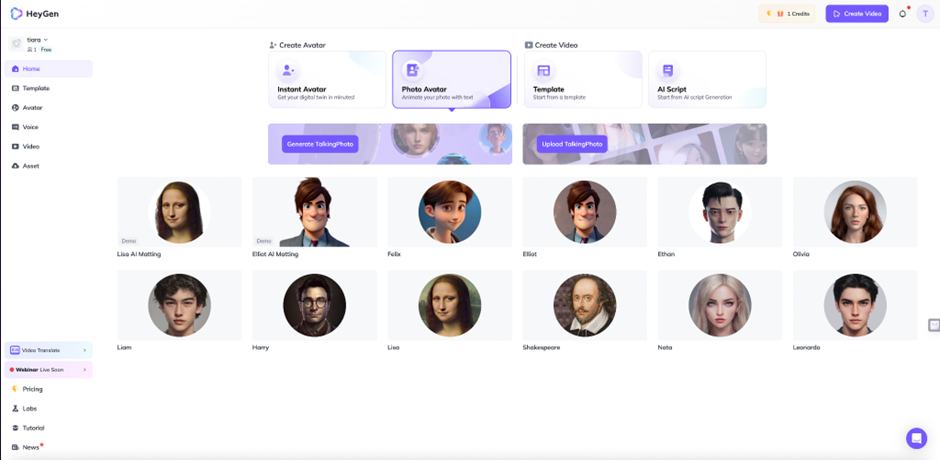
Step 2: You can either generate your ideal avatar:
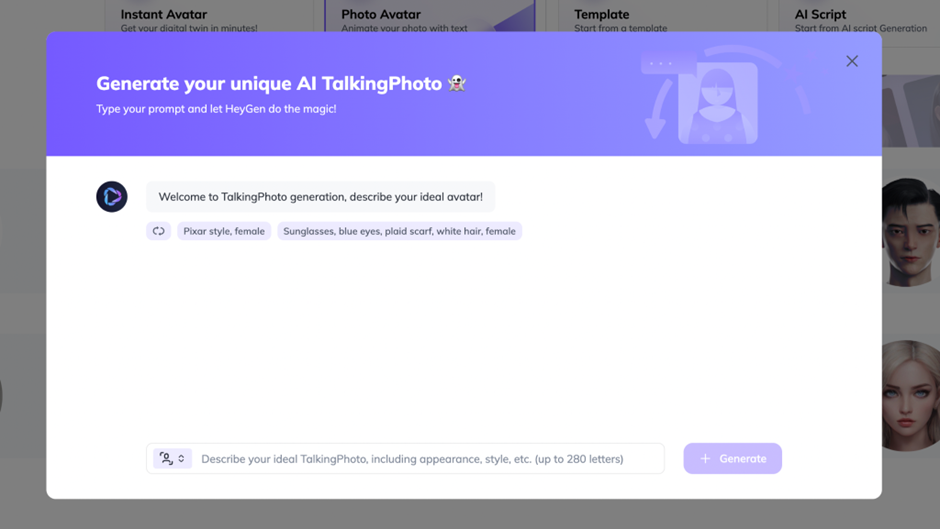
or you can upload your own photo (once you uploaded your photo, you’ll see it on the top left):
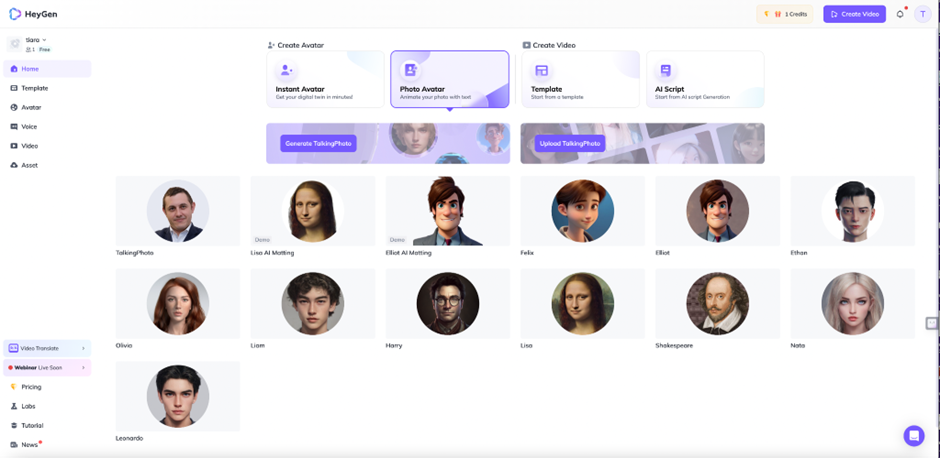
Step 3: You can edit the picture before creating the talking photo. Choose the view mode, remove the background if desired, and select the AI voice you like. Don’t worry about the voice; you can change it later. Once you’re satisfied, click on “Save Changes.”
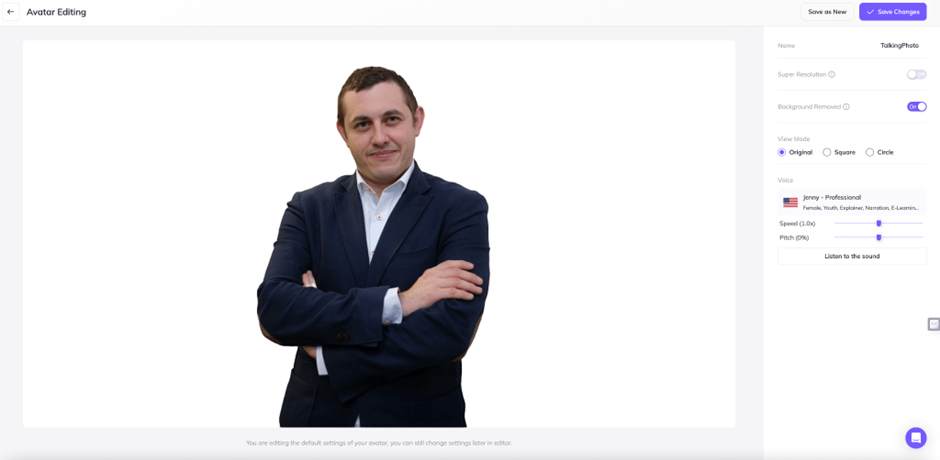

Step 4: You’ll be redirected to the dashboard. Select your picture again and choose ‘Create Video’. You can opt for either Landscape or Portrait format, which is great for social media posts like Instagram and TikTok:
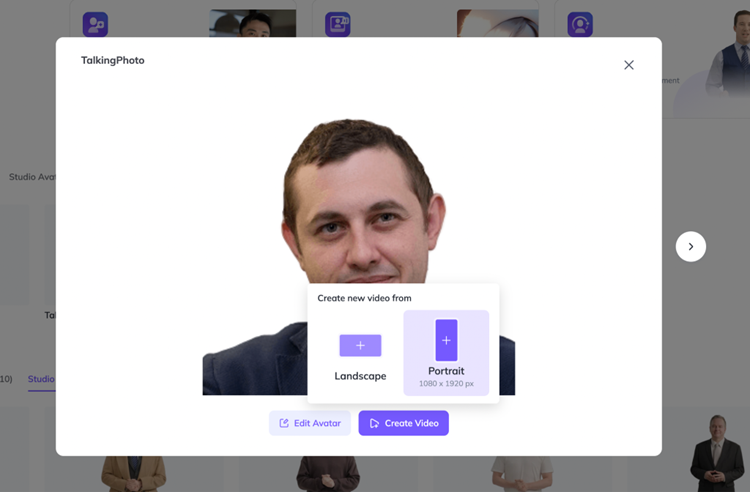
Step 5: Now, add your script. You can type your script or use “Audio Script” for automatic transcription. If you want the AI to pause between sentences, hit ‘Enter’ to start a new line. On the right-hand side, you can select the AI voice again (some AI voices are only available for pro users, but the free versions already sound good and natural) and even listen to a preview:

Step 6: And you’re done! Click ‘Submit’ in the top right corner. 0.5 credit is needed to create this talking photo. Then hit ‘Submit’ again. You will be notified by email when the video is ready, and you can also find it in your dashboard.

Congratulations on creating your talking photo avatar! This innovative tool opens up new possibilities for engagement and creativity on social media.
Don’t hesitate to keep experimenting with different images and scripts to discover what resonates best with you and your audience. Share your masterpieces on social media and tag me on Instagram – I’d love to see your creativity in action and am here to support any further customizations or questions you might have.
Happy creating, and here’s to pushing the boundaries of digital creativity!
7. AI in Marketing: Boost Your Business
Subtitle: “Maximizing Profits with AI-Driven Marketing Strategies

In today’s fast-paced business world, marketing automation has become a cornerstone for success, particularly for small to medium-sized businesses. With the advent of Artificial Intelligence (AI), marketing automation is not just a tool for efficiency; it’s a platform for personalization, predictive analytics, and strategic growth.
Here are the benefits of integrating AI into your marketing automation and how it can revolutionize your business approach:
The Power of Personalization
AI elevates marketing automation by enabling hyper-personalized customer experiences. A study by McKinsey highlights that 71% of consumers expect personalization in their interactions with businesses. AI algorithms analyze customer data and behaviors, facilitating tailored marketing messages that resonate on a personal level. For instance, Whole Foods’ use of AI to send customized promotional messages based on purchase history exemplifies this trend. This level of personalization not only enhances customer engagement but also significantly improves conversion rates. (SOURCE: https://blog.hubspot.com/marketing/ai-marketing-automation)
Use tools like Adobe Experience Platform or Salesforce Marketing Cloud to leverage AI for personalization. These platforms offer advanced data analysis capabilities to tailor customer interactions based on their preferences and behaviors.
Email Automation Revolutionized
The days of one-size-fits-all email campaigns are long gone. AI-driven email automation allows businesses to send highly personalized emails to large audiences without the manual effort. These systems can analyze real-time performance, offering insights to continually refine email strategies. This approach not only saves time but also ensures that your message is always relevant and engaging to each recipient.
Mailchimp and HubSpot provide AI-driven features for email marketing. They allow businesses to personalize emails and automate the delivery based on customer interactions and preferences.
Lead Scoring and Nurturing with AI
Determining which leads are most likely to convert can be a daunting task. AI simplifies this by efficiently analyzing lead data, ensuring that marketing efforts are focused on the most promising prospects. Furthermore, AI can automate the lead nurturing process, guiding potential customers through the sales funnel with minimal human intervention. This automated, yet personalized journey significantly boosts conversion rates and optimizes marketing resources.
Marketo and Pardot offer AI capabilities for lead scoring and nurturing. They can intelligently prioritize leads and automate targeted marketing content, nurturing leads more effectively through the sales funnel.
Predictive Analytics: Anticipating the Future
AI isn’t just about reacting to current trends; it’s also about anticipating future ones. Using advanced algorithms, AI can predict customer behaviors and market shifts, allowing businesses to be proactive rather than reactive. This foresight is invaluable for aligning marketing strategies with emerging trends and staying ahead of the competition.
Google Analytics and IBM Watson offer predictive analytics features. They can analyze patterns in customer data and predict future behaviors, helping businesses make informed marketing decisions.
Channel Optimization for Maximum Impact
With numerous marketing channels available, identifying the most effective ones can be challenging. AI algorithms excel at determining which channels yield the best ROI, allowing businesses to allocate resources more effectively. This strategic approach ensures that marketing efforts are not only efficient but also impactful.
Hootsuite and Sprout Social incorporate AI to help identify the most effective marketing channels. They analyze performance across different platforms to optimize channel strategy for the best engagement and ROI.
AI-Enhanced Customer Service
AI’s role in marketing isn’t limited to outbound strategies. AI-powered chatbots and virtual assistants can significantly enhance customer service by providing quick, accurate responses to inquiries. This not only improves the customer experience but also frees up valuable human resources for more complex tasks.
Zendesk and Intercom use AI to enhance customer service. They offer chatbot and virtual assistant functionalities to quickly address customer queries, improving response times and service quality.
Conclusion
Integrating AI into marketing automation is not just a technological upgrade; it’s a strategic evolution. It allows businesses to personalize interactions, optimize resource allocation, and stay ahead of market trends. The result is a more efficient, effective, and engaging marketing strategy that drives growth and customer loyalty. As AI technology continues to advance, its role in marketing automation will only become more integral, offering endless possibilities for innovation and success.


